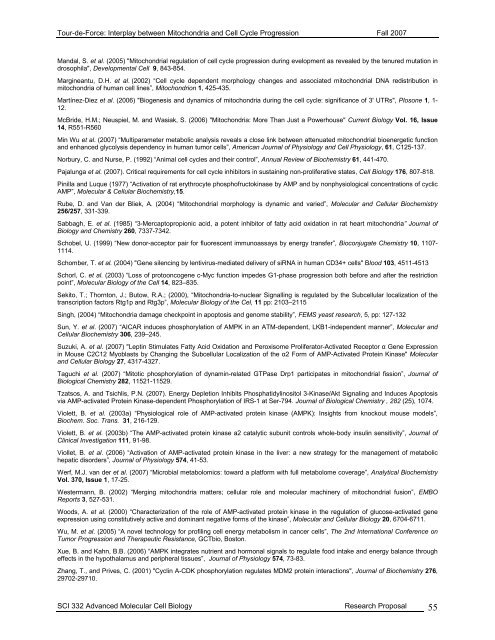Tour-de-Force
Tour-de-Force
Tour-de-Force
Create successful ePaper yourself
Turn your PDF publications into a flip-book with our unique Google optimized e-Paper software.
<strong>Tour</strong>-<strong>de</strong>-<strong>Force</strong>: Interplay between Mitochondria and Cell Cycle Progression Fall 2007Mandal, S. et al. (2005) "Mitochondrial regulation of cell cycle progression during evelopment as revealed by the tenured mutation indrosophila", Developmental Cell 9, 843-854.Margineantu, D.H. et al. (2002) “Cell cycle <strong>de</strong>pen<strong>de</strong>nt morphology changes and associated mitochondrial DNA redistribution inmitochondria of human cell lines”, Mitochondrion 1, 425-435.Martínez-Diez et al. (2006) "Biogenesis and dynamics of mitochondria during the cell cycle: significance of 3' UTRs", Plosone 1, 1-12.McBri<strong>de</strong>, H.M.; Neuspiel, M. and Wasiak, S. (2006) "Mitochondria: More Than Just a Powerhouse" Current Biology Vol. 16, Issue14, R551-R560Min Wu et al. (2007) “Multiparameter metabolic analysis reveals a close link between attenuated mitochondrial bioenergetic functionand enhanced glycolysis <strong>de</strong>pen<strong>de</strong>ncy in human tumor cells”, American Journal of Physiology and Cell Physiology, 61, C125-137.Norbury, C. and Nurse, P. (1992) “Animal cell cycles and their control”, Annual Review of Biochemistry 61, 441-470.Pajalunga et al. (2007). Critical requirements for cell cycle inhibitors in sustaining non-proliferative states, Cell Biology 176, 807-818.Pinilla and Luque (1977) “Activation of rat erythrocyte phosphofructokinase by AMP and by nonphysiological concentrations of cyclicAMP”, Molecular & Cellular Biochemistry,15.Rube, D. and Van <strong>de</strong>r Bliek, A. (2004) “Mitochondrial morphology is dynamic and varied”, Molecular and Cellular Biochemistry256/257, 331-339.Sabbagh, E. et al. (1985) “3-Mercaptopropionic acid, a potent inhibitor of fatty acid oxidation in rat heart mitochondria” Journal ofBiology and Chemistry 260, 7337-7342.Schobel, U. (1999) “New donor-acceptor pair for fluorescent immunoassays by energy transfer”, Bioconjugate Chemistry 10, 1107-1114.Schomber, T. et al. (2004) "Gene silencing by lentivirus-mediated <strong>de</strong>livery of siRNA in human CD34+ cells" Blood 103, 4511-4513Schorl, C. et al. (2003) “Loss of protooncogene c-Myc function impe<strong>de</strong>s G1-phase progression both before and after the restrictionpoint”, Molecular Biology of the Cell 14, 823–835.Sekito, T.; Thornton, J.; Butow, R.A.; (2000), “Mitochondria-to-nuclear Signalling is regulated by the Subcellular localization of thetranscription factors Rtg1p and Rtg3p”, Molecular Biology of the Cel, 11 pp: 2103–2115Singh, (2004) “Mitochondria damage checkpoint in apoptosis and genome stability”, FEMS yeast research, 5, pp: 127-132Sun, Y. et al. (2007) “AICAR induces phosphorylation of AMPK in an ATM-<strong>de</strong>pen<strong>de</strong>nt, LKB1-in<strong>de</strong>pen<strong>de</strong>nt manner”, Molecular andCellular Biochemistry 306, 239–245.Suzuki, A. et al. (2007) "Leptin Stimulates Fatty Acid Oxidation and Peroxisome Proliferator-Activated Receptor α Gene Expressionin Mouse C2C12 Myoblasts by Changing the Subcellular Localization of the α2 Form of AMP-Activated Protein Kinase" Molecularand Cellular Biology 27, 4317-4327.Taguchi et al. (2007) “Mitotic phosphorylation of dynamin-related GTPase Drp1 participates in mitochondrial fission”, Journal ofBiological Chemistry 282, 11521-11529.Tzatsos, A. and Tsichlis, P.N. (2007). Energy Depletion Inhibits Phosphatidylinositol 3-Kinase/Akt Signaling and Induces Apoptosisvia AMP-activated Protein Kinase-<strong>de</strong>pen<strong>de</strong>nt Phosphorylation of IRS-1 at Ser-794. Journal of Biological Chemistry , 282 (25), 1074.Violett, B. et al. (2003a) “Physiological role of AMP-activated protein kinase (AMPK): Insights from knockout mouse mo<strong>de</strong>ls”,Biochem. Soc. Trans. 31, 216-129.Violett, B. et al. (2003b) “The AMP-activated protein kinase a2 catalytic subunit controls whole-body insulin sensitivity”, Journal ofClinical Investigation 111, 91-98.Viollet, B. et al. (2006) “Activation of AMP-activated protein kinase in the liver: a new strategy for the management of metabolichepatic disor<strong>de</strong>rs”, Journal of Physiology 574, 41-53.Werf, M.J. van <strong>de</strong>r et al. (2007) “Microbial metabolomics: toward a platform with full metabolome coverage”, Analytical BiochemistryVol. 370, Issue 1, 17-25.Westermann, B. (2002) “Merging mitochondria matters; cellular role and molecular machinery of mitochondrial fusion”, EMBOReports 3, 527-531.Woods, A. et al. (2000) “Characterization of the role of AMP-activated protein kinase in the regulation of glucose-activated geneexpression using constitutively active and dominant negative forms of the kinase”, Molecular and Cellular Biology 20, 6704-6711.Wu, M. et al. (2005) “A novel technology for profiling cell energy metabolism in cancer cells”, The 2nd International Conference onTumor Progression and Therapeutic Resistance, GCTbio, Boston.Xue, B. and Kahn, B.B. (2006) “AMPK integrates nutrient and hormonal signals to regulate food intake and energy balance througheffects in the hypothalamus and peripheral tissues”, Journal of Physiology 574, 73-83.Zhang, T., and Prives, C. (2001) "Cyclin A-CDK phosphorylation regulates MDM2 protein interactions", Journal of Biochemistry 276,29702-29710.SCI 332 Advanced Molecular Cell Biology Research Proposal 55
















